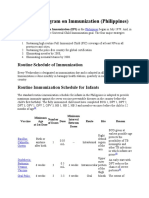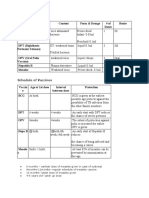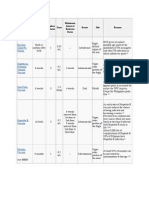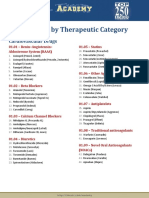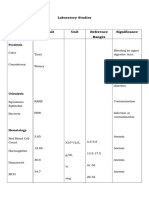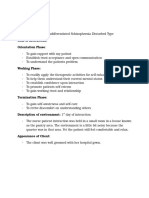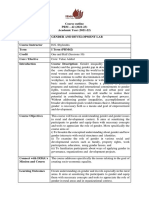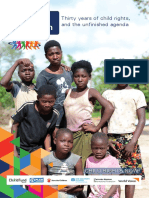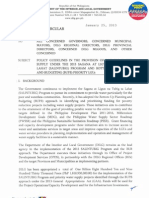Vaccine Minimum Age at 1st Dose Number of Doses Dose Minimum Interval Between Doses Route Site Reason
Vaccine Minimum Age at 1st Dose Number of Doses Dose Minimum Interval Between Doses Route Site Reason
Uploaded by
Kris TejereroOriginal Description:
Original Title
Copyright
Available Formats
Share this document
Did you find this document useful?
Is this content inappropriate?
Copyright:
Available Formats
Vaccine Minimum Age at 1st Dose Number of Doses Dose Minimum Interval Between Doses Route Site Reason
Vaccine Minimum Age at 1st Dose Number of Doses Dose Minimum Interval Between Doses Route Site Reason
Uploaded by
Kris TejereroCopyright:
Available Formats
Minimum Number
Minimum Interval
Vaccine Age of Dose Route Site Reason
Between Doses
at 1st Dose Doses
BCG given at earliest possible age
Birth or
Bacillus 0.05 Right deltoid region protects the possibility of TB meningitis
anytime after 1 dose none Intradermal
Calmette-Gurin mL of the arm and other TB infections in which infants
birth
are prone[3]
Diphtheria- 6 weeks(DPT 1), 10 Upper outer portion
0.5 An early start with DPT reduces the
Pertussis-Tetanus 6 weeks old 3 doses weeks (DPT 2), 14 Intramuscular of the thigh, Vastus
mL chance of severe pertussis.[4]
Vaccine weeks (DPT 3) Lateralis (L-R-L)
The extent of protection against polio is
Oral Polio 2-3
6 weeks old 3 doses 4 weeks Oral Mouth increased the earlier the OPV is given.
Vaccine drops
Keeps the Philippines polio-free.[5]
An early start of Hepatitis B vaccine
reduces the chance of being infected and
becoming a carrier.[6]
Upper outer portion Prevents liver cirrhosis and liver cancer
Hepatitis B 0.5
At birth 3 doses 4 weeks interval Intramuscular of the thigh, Vastus which are more likely to develop if infected
Vaccine mL
Lateralis (R-L-R) with Hepatitis B early in life.[7][8]
About 9,000 died of complications of
Hepatitis B. 10% of Filipinos have
Hepatitis B infection[9]
Measles Vaccine Upper outer portion
0.5 At least 85% of measles can be prevented
9 months old 1 dose none Subcutaneous of the arms, Right
mL by immunization at this age.[10]
deltiod
(not MMR)
General Principles in Infants/Children Immunization[edit]
Because measles kills, every infant needs to be vaccinated against measles at the age of 9 months or as soon as possible after 9 months as part of the
routine infant vaccination schedule. It is safe to vaccinate a sick child who is suffering from a minor illness (cough, cold, diarrhea, fever or malnutrition) or who has
already been vaccinated against measles.[11]
If the vaccination schedule is interrupted, it is not necessary to restart. Instead, the schedule should be resumed using minimal intervals between doses to
catch up as quickly as possible.[12]
Vaccine combinations (few exceptions), antibiotics, low-dose steroids (less than 20 mg per day), minor infections with low fever (below 38.5 Celsius),
diarrhea, malnutrition, kidney or liver disease, heart or lung disease, non-progressive encephalopathy, well controlled epilepsy or advanced age, are not
contraindications to vaccination. Contrary to what the majority of doctors may think, vaccines against hepatitis B and tetanus can be applied in any period of the
pregnancy.[13]
There are very few true contraindication and precaution conditions. Only two of these conditions are generally considered to be permanent: severe
(anaphylactic) allergic reaction to a vaccine component or following a prior dose of a vaccine, and encephalopathy not due to another identifiable cause occurring
within 7 days of pertussis vaccination.[14]
Only the diluent supplied by the manufacturer should be used to reconstitute a freeze-dried vaccine. A sterile needle and sterile syringe must be used for each
vial for adding the diluent to the powder in a single vial or ampoule of freeze-dried vaccine. [15]
The only way to be completely safe from exposure to blood-borne diseases from injections, particularly hepatitis B virus (HBV), hepatitis C virus (HCV), and
human immunodeficiency virus (HIV) is to use one sterile needle, one sterile syringe for each child. [16]
Tetanus Toxoid Immunization Schedule for Women[edit]
When given to women of childbearing age, vaccines that contain tetanus toxoid (TT or Td) not only protect women against tetanus, but also prevent neonatal tetanus
in their newborn infants.[17]
Minimum Percent
Vaccine Duration of Protection
Age/Interval Protected
TT1 At 20th weeks AOG 0%
protection for the mother for the first delivery
TT2 At least 4 weeks later 80%
infants born to the mother will be protected from neonatal tetanus
gives 3 years protection for the mother
infants born to the mother will be protected from neonatal tetanus
TT3 At least 6 months later 95%
gives 5 years protection for the mother
infants born to the mother will be protected from neonatal tetanus
TT4 At least 1 year later 99%
gives 10 years protection for the mother
gives lifetime protection for the mother
TT5 At least 1 year later 99%
all infants born to that mother will be protected
In June 2000, the 57 countries that have not yet achieved elimination of neonatal tetanus were ranked and the Philippines was listed together with 22 other countries
in Class A, a classification for countries close to maternal and neonatal tetanus elimination. [18]
The Millennium Development Goals:
1. Eradicate extreme poverty and hunger
Reduce by half the proportion of people living on less than a dollar a day.
Reduce by half the proportion of people who suffer from hunger.
2. Achieve universal primary education
Ensure that all boys and girls complete a full course of primary schooling.
3. Promote gender equality and empower women
Eliminate gender disparity in primary and secondary education preferably by 2005, and at all levels by 2015.
4. Reduce child mortality
Reduce by two thirds the mortality rate among children under five.
5. Improve maternal health
Reduce by three quarters the maternal mortality ratio.
6. Combat HIV/AIDS, malaria and other diseases
Halt and begin to reverse the spread of HIV/AIDS.
Halt and begin to reverse the incidence of malaria and other major diseases.
7. Ensure environmental sustainability
Integrate the principles of sustainable development into country policies and programs; reverse loss of environmental resources.
Reduce by half the proportion of people without sustainable access to safe drinking water.
Achieve significant improvement in lives of at least 100 million slum dwellers, by 2020.
8. Develop a global partnership for development
Develop further an open trading and financial system that is rule-based, predictable and non-discriminatory. Includes a commitment to good governance, development and poverty
reductionnationally and internationally.
Address the least developed countries special needs. This includes tariff- and quota-free access for their exports; enhanced debt relief for heavily indebted poor countries; cancellation
of official bilateral debt; and more generous official development assistance for countries committed to poverty reduction.
Address the special needs of landlocked and small island developing States.
Deal comprehensively with developing countries debt problems through national and international measures to make debt sustainable in the long term.
In cooperation with the developing countries, develop decent and productive work for youth.
In cooperation with pharmaceutical companies, provide access to affordable essential drugs in developing countries.
In cooperation with the private sector, make available the benefits of new technologiesespecially information and communications technologies.
You might also like
- Expanded Program On Immunization Philippines)Document8 pagesExpanded Program On Immunization Philippines)Mark AcuzarNoch keine Bewertungen
- Routine Immunization Schedule For InfantsDocument2 pagesRoutine Immunization Schedule For InfantsknotstmNoch keine Bewertungen
- Vaccine Minimum Age at 1st Dose Number of Doses Dose Minimum Interval Between Doses Route Site ReasonDocument3 pagesVaccine Minimum Age at 1st Dose Number of Doses Dose Minimum Interval Between Doses Route Site ReasonMaui LopezNoch keine Bewertungen
- Routine Immunization Schedule For Infants: Bacillus Calmette-Guérin Diphtheria - Pertussis - Tetanus VaccineDocument4 pagesRoutine Immunization Schedule For Infants: Bacillus Calmette-Guérin Diphtheria - Pertussis - Tetanus VaccinewatabeeNoch keine Bewertungen
- Bacillus Calmette-Guérin: (Not MMR)Document2 pagesBacillus Calmette-Guérin: (Not MMR)Shanne ShamsuddinNoch keine Bewertungen
- Expanded Program On ImmunizationDocument1 pageExpanded Program On ImmunizationPhoebe Yen Paulite ManapsalNoch keine Bewertungen
- Expanded Program On ImmunizationDocument4 pagesExpanded Program On ImmunizationAlpah DesamparadoNoch keine Bewertungen
- The Expanded Program On ImmunizationDocument4 pagesThe Expanded Program On Immunizationapi-3745792100% (3)
- Expanded Program On ImmunizationDocument5 pagesExpanded Program On ImmunizationFreya Revamonte100% (8)
- Expanded Program On Immunization and Reproductive Health DOH Programs PDFDocument24 pagesExpanded Program On Immunization and Reproductive Health DOH Programs PDFMiss GNoch keine Bewertungen
- Expanded Program On ImmunizationDocument7 pagesExpanded Program On ImmunizationkakilalaNoch keine Bewertungen
- Vaccine Minimum Age at 1st Dose Number of Doses Dose Minimum Interval Between Doses Route Site ReasonDocument2 pagesVaccine Minimum Age at 1st Dose Number of Doses Dose Minimum Interval Between Doses Route Site ReasonBobbie LittleNoch keine Bewertungen
- Expanded Program On ImmunizationDocument10 pagesExpanded Program On ImmunizationHoneylouAzOpondaNoch keine Bewertungen
- Mandatory Infants and Children Health Immunization Act of 2011 Compulsory ImmunizationDocument3 pagesMandatory Infants and Children Health Immunization Act of 2011 Compulsory Immunizationbunso padilla100% (2)
- Expanded Program On Immunization (Philippines) : Routine Schedule of ImmunizationDocument4 pagesExpanded Program On Immunization (Philippines) : Routine Schedule of ImmunizationSophia Faith Aplaca ParentilaNoch keine Bewertungen
- Immunization EPIDocument1 pageImmunization EPIandreabreeNoch keine Bewertungen
- Vaccine Minimum Age at 1st Dose Number of Doses Dose Minimum Interval Between Doses Route Site ReasonDocument3 pagesVaccine Minimum Age at 1st Dose Number of Doses Dose Minimum Interval Between Doses Route Site ReasonVirgie Capistrano100% (1)
- VaccineDocument2 pagesVaccineErnest SyNoch keine Bewertungen
- DOH Programs Group 1 BSN 2L 1Document19 pagesDOH Programs Group 1 BSN 2L 1Jocelyn AtisNoch keine Bewertungen
- ImmunizationDocument6 pagesImmunizationNIKAH PAULINE ALCANTARANoch keine Bewertungen
- VaccineDocument1 pageVaccineGoerge MoncioNoch keine Bewertungen
- Bacillus Calmette - Guérin: Oral Polio VaccineDocument1 pageBacillus Calmette - Guérin: Oral Polio VaccineElleNoch keine Bewertungen
- Principles of EPI: Community Health Nursing Expanded Program For Immunization (EPI)Document2 pagesPrinciples of EPI: Community Health Nursing Expanded Program For Immunization (EPI)Rona Pie100% (1)
- National Immunization ProgramDocument9 pagesNational Immunization Programjuanamay30gmailcomNoch keine Bewertungen
- Eversley Requirement2Document3 pagesEversley Requirement2Nedeve OznedNoch keine Bewertungen
- VaccineDocument1 pageVaccinexmitchxNoch keine Bewertungen
- Vaccine IMCIDocument2 pagesVaccine IMCIEricNoch keine Bewertungen
- National Immunization ProgramDocument9 pagesNational Immunization ProgramCriselda PabuaNoch keine Bewertungen
- NCM 104 Community Health Nursing RLEDocument28 pagesNCM 104 Community Health Nursing RLEMARIA YVA SARITANoch keine Bewertungen
- Expanded Program On ImmunizationDocument8 pagesExpanded Program On Immunizationjanine_valdezNoch keine Bewertungen
- IMMUNIZATION (Health Education)Document33 pagesIMMUNIZATION (Health Education)Rozel Encarnacion100% (2)
- Vaccine Minimum Age at 1st Dose Number of Doses Dose Minimum Interval Between Doses Route Site ReasonDocument2 pagesVaccine Minimum Age at 1st Dose Number of Doses Dose Minimum Interval Between Doses Route Site ReasonTan Rn RmNoch keine Bewertungen
- Vaccine Minimum Age at 1st Dose Doses Dose Interval Route Site ReasonDocument2 pagesVaccine Minimum Age at 1st Dose Doses Dose Interval Route Site ReasonLawrence NemirNoch keine Bewertungen
- Sammy JamesDocument3 pagesSammy JamesTekels CurtisNoch keine Bewertungen
- Epi ReviewerDocument4 pagesEpi ReviewerHannah VueltaNoch keine Bewertungen
- Brocure ImmunizationDocument3 pagesBrocure ImmunizationGil AswiguiNoch keine Bewertungen
- Expanded Program On ImmunizationDocument1 pageExpanded Program On ImmunizationGemgem AcostaNoch keine Bewertungen
- Expanded Program On Immunization (Epi) : Presented By: Fatima T. Botin, RM, RNDocument40 pagesExpanded Program On Immunization (Epi) : Presented By: Fatima T. Botin, RM, RNRose Anne Tusi Botin100% (1)
- VACCINESDocument3 pagesVACCINESMec AmilasanNoch keine Bewertungen
- The Expanded Program On ImmunizationDocument5 pagesThe Expanded Program On ImmunizationStephen EleserioNoch keine Bewertungen
- Minimum Age at 1st Dose Number of Doses Dose Minimum Interval Between Doses Route Site ReasonDocument3 pagesMinimum Age at 1st Dose Number of Doses Dose Minimum Interval Between Doses Route Site ReasonArra PlacidesNoch keine Bewertungen
- IMMUNIZATIONDocument17 pagesIMMUNIZATIONZenasB.PalomaNoch keine Bewertungen
- Immunization: Vaccine Minimum AGE at 1St Dose Number OF Doses Minimum Interval Between Doses ReasonDocument1 pageImmunization: Vaccine Minimum AGE at 1St Dose Number OF Doses Minimum Interval Between Doses ReasonShiela May GoNoch keine Bewertungen
- Expanded Program On Immunization (Philippines)Document10 pagesExpanded Program On Immunization (Philippines)Karen Bianca Espinola, MD. DPBA.Noch keine Bewertungen
- EpiDocument5 pagesEpiMarie Dinah SalvinoNoch keine Bewertungen
- Immunization: Expanded Program On Immunization (EPI)Document4 pagesImmunization: Expanded Program On Immunization (EPI)3amabelle arevaloNoch keine Bewertungen
- VaccineDocument3 pagesVaccinePapitas FritasNoch keine Bewertungen
- Expanded Program On Immunization (EPI) 7 Vaccine-Preventable Diseases VaccinesDocument7 pagesExpanded Program On Immunization (EPI) 7 Vaccine-Preventable Diseases VaccinesLuiciaNoch keine Bewertungen
- Epi ImciDocument15 pagesEpi ImciHoloNoch keine Bewertungen
- Bacillus Calmette-Guérin: (Not MMR)Document1 pageBacillus Calmette-Guérin: (Not MMR)William Oz CiferNoch keine Bewertungen
- Vaccination: Passive ImmunityDocument12 pagesVaccination: Passive ImmunityuouoNoch keine Bewertungen
- ROUTINE IMMUNIZATION SCHEDULE For INFANTSDocument7 pagesROUTINE IMMUNIZATION SCHEDULE For INFANTSJessica GlitterNoch keine Bewertungen
- Expanded Program of Immunization (Source: DOH)Document12 pagesExpanded Program of Immunization (Source: DOH)Jefferson Dungca94% (35)
- CHNDocument14 pagesCHNAi IrenNoch keine Bewertungen
- The 7 Immunizable Diseases AreDocument6 pagesThe 7 Immunizable Diseases AreGladie Ann Dela RosaNoch keine Bewertungen
- Expanded Program On Immunization AbujenDocument2 pagesExpanded Program On Immunization AbujenAlhaisa BejemilNoch keine Bewertungen
- Drug StudyDocument2 pagesDrug StudyCarlo AniagNoch keine Bewertungen
- Old Diseases Are Coming Back:: Courtesy Of Anti-VaccinatorsFrom EverandOld Diseases Are Coming Back:: Courtesy Of Anti-VaccinatorsRating: 1 out of 5 stars1/5 (1)
- Health Advice and Immunizations for TravelersFrom EverandHealth Advice and Immunizations for TravelersNoch keine Bewertungen
- PCM (8) Test For Significance (Dr. Tante)Document151 pagesPCM (8) Test For Significance (Dr. Tante)Kris TejereroNoch keine Bewertungen
- Ronel NaireDocument4 pagesRonel NaireKris TejereroNoch keine Bewertungen
- By: Kris Lyn L. TejereoDocument30 pagesBy: Kris Lyn L. TejereoKris TejereroNoch keine Bewertungen
- Lab ANA Set 2Document6 pagesLab ANA Set 2Kris TejereroNoch keine Bewertungen
- Dr. Edgar Gasco Anatomy LabDocument3 pagesDr. Edgar Gasco Anatomy LabKris TejereroNoch keine Bewertungen
- Pharma Reviewer From VinnyDocument16 pagesPharma Reviewer From VinnyKris TejereroNoch keine Bewertungen
- Drug List by Therapeutic Category: Cardiovascular DrugsDocument7 pagesDrug List by Therapeutic Category: Cardiovascular DrugsAloah122346Noch keine Bewertungen
- School Stage RoofingDocument12 pagesSchool Stage RoofingKris TejereroNoch keine Bewertungen
- Area Inspection Palpation Auscultation Percussion: Physical AssessmentDocument6 pagesArea Inspection Palpation Auscultation Percussion: Physical AssessmentKris TejereroNoch keine Bewertungen
- NCM 104 Cellular Aberration Lecture 2007Document104 pagesNCM 104 Cellular Aberration Lecture 2007Kris Tejerero100% (1)
- Laboratory Studies: FecalysisDocument2 pagesLaboratory Studies: FecalysisKris TejereroNoch keine Bewertungen
- Cellular AberrationDocument71 pagesCellular AberrationKris TejereroNoch keine Bewertungen
- Nursing Care Plan: Name of Patient: - Age: - SexDocument4 pagesNursing Care Plan: Name of Patient: - Age: - SexKris TejereroNoch keine Bewertungen
- Process Recording WMCCDocument3 pagesProcess Recording WMCCKris TejereroNoch keine Bewertungen
- Algor Mortis - Cooling of The Body-: Antemortem Agonal Period Postmortem Postmortem ChangesDocument13 pagesAlgor Mortis - Cooling of The Body-: Antemortem Agonal Period Postmortem Postmortem ChangesKris TejereroNoch keine Bewertungen
- HIV DrugsDocument31 pagesHIV DrugsKris TejereroNoch keine Bewertungen
- Universal Health CareDocument4 pagesUniversal Health CareAeloran Jullienne Cailles (Aelora Jullienne)Noch keine Bewertungen
- MC2 Concept PaperDocument8 pagesMC2 Concept PaperAlvin Cloyd Dakis, MHSS, RN, CGDPNoch keine Bewertungen
- Cost Determination and Sustainable Financing For Rural Water Services in Sub-Saharan AfricaDocument19 pagesCost Determination and Sustainable Financing For Rural Water Services in Sub-Saharan AfricaRizki Muda KeulanaNoch keine Bewertungen
- RIO SummitDocument13 pagesRIO Summitabhinavsingh154Noch keine Bewertungen
- WHO Working Paper #2Document2 pagesWHO Working Paper #2Vaibhav PenukondaNoch keine Bewertungen
- Nyagatare PotentialitiesDocument97 pagesNyagatare PotentialitiesBernard Palmer0% (1)
- CPH ReviewerDocument47 pagesCPH ReviewerCamila GamayanNoch keine Bewertungen
- Gender Based Violence and Formulating Adequate Policy ResponsesDocument44 pagesGender Based Violence and Formulating Adequate Policy ResponsesThess Cahigas - NavaltaNoch keine Bewertungen
- 1213AV ECA Concept Note Food Security WomenDocument4 pages1213AV ECA Concept Note Food Security WomenAbass GblaNoch keine Bewertungen
- Social Problems of Pakistan: Mohammad Ali Babakhel PSPDocument28 pagesSocial Problems of Pakistan: Mohammad Ali Babakhel PSPAmeena AimenNoch keine Bewertungen
- Sustainable Development Cooperation Framework Between Government of The State of Eritrea and The United Nations 2022-2026Document33 pagesSustainable Development Cooperation Framework Between Government of The State of Eritrea and The United Nations 2022-2026nadraspareNoch keine Bewertungen
- Malawi National Urban ProfileDocument52 pagesMalawi National Urban ProfileUnited Nations Human Settlements Programme (UN-HABITAT)Noch keine Bewertungen
- 2011 Newborn Care SOP 29-11-11Document95 pages2011 Newborn Care SOP 29-11-11Safiqul Islam ShawnNoch keine Bewertungen
- Education of Children With Special Needs in Ethiopia: Analysis of The Rhetoric of Education For All and The Reality On The GroundDocument53 pagesEducation of Children With Special Needs in Ethiopia: Analysis of The Rhetoric of Education For All and The Reality On The GroundSaalih YuunaaNoch keine Bewertungen
- Tanzania-National Urban ProfileDocument40 pagesTanzania-National Urban ProfileUnited Nations Human Settlements Programme (UN-HABITAT)Noch keine Bewertungen
- Madagascar 2014Document12 pagesMadagascar 2014HayZara MadagascarNoch keine Bewertungen
- Gender Inequality Position PapersDocument22 pagesGender Inequality Position PapersHong Kong MUN 201383% (6)
- Vol 1 Water Sector GovernanceDocument102 pagesVol 1 Water Sector GovernanceJuan I. RecabeitiaNoch keine Bewertungen
- G&D Lab 2021 42 Reading Material HSS - PRM41Document103 pagesG&D Lab 2021 42 Reading Material HSS - PRM41Rohit MukherjeeNoch keine Bewertungen
- A Second Revolution ENGDocument60 pagesA Second Revolution ENGsofiabloemNoch keine Bewertungen
- Ayrh StrategyDocument68 pagesAyrh StrategyLeel BurtukanNoch keine Bewertungen
- Commu. II UNIT 4Document9 pagesCommu. II UNIT 4bashaNoch keine Bewertungen
- DOH Updated Programs A-FDocument61 pagesDOH Updated Programs A-Fdeeday echavezNoch keine Bewertungen
- Position Paper-African UnionDocument2 pagesPosition Paper-African UnionanisaiprNoch keine Bewertungen
- Activity 2Document7 pagesActivity 2Karen T. CeletariaNoch keine Bewertungen
- United Nations Commission On International Trade Law (UNCITRAL)Document18 pagesUnited Nations Commission On International Trade Law (UNCITRAL)nayan123321Noch keine Bewertungen
- Epidemiological and Nutrition Transition in Developing Countries: Impact On Human Health and DevelopmentDocument9 pagesEpidemiological and Nutrition Transition in Developing Countries: Impact On Human Health and DevelopmentariniNoch keine Bewertungen
- DILG Memo Circular Salintubig 2013130 4e016b593fDocument33 pagesDILG Memo Circular Salintubig 2013130 4e016b593fEduardo MedranoNoch keine Bewertungen
- Political Participation of Women A Case Study in India PDFDocument18 pagesPolitical Participation of Women A Case Study in India PDFRod EllaineNoch keine Bewertungen
- Achieving The Millennium Developmeny Goals in The Asia-Pacific Region - The Role of International AssistanceDocument16 pagesAchieving The Millennium Developmeny Goals in The Asia-Pacific Region - The Role of International AssistanceroblagrNoch keine Bewertungen














